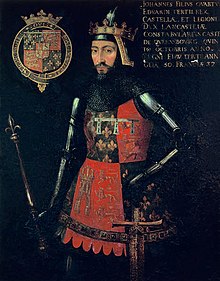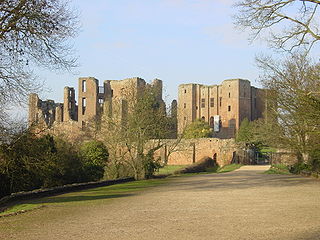
Kenilworth Castle is a castle in the town of Kenilworth in Warwickshire, England managed by English Heritage; much of it is still in ruins. The castle was founded during the Norman conquest of England; with development through to the Tudor period. It has been described by the architectural historian Anthony Emery as "the finest surviving example of a semi-royal palace of the later middle ages, significant for its scale, form and quality of workmanship".
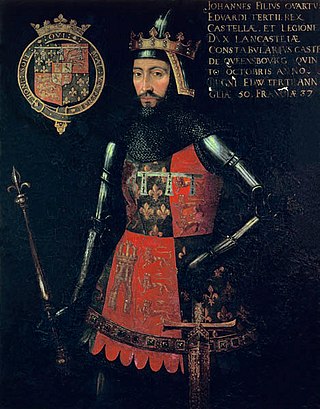
John of Gaunt, Duke of Lancaster was an English royal prince, military leader, and statesman. He was the third surviving son of King Edward III of England, and the father of King Henry IV. Due to Gaunt's royal origin, advantageous marriages, and some generous land grants, he was one of the richest men of his era, and was an influential figure during the reigns of both his father and his nephew, Richard II. As Duke of Lancaster, he is the founder of the royal House of Lancaster, whose members would ascend the throne after his death. His birthplace, Ghent in Flanders, then known in English as Gaunt, was the origin of his name. When he became unpopular later in life, a scurrilous rumour circulated, along with lampoons, claiming that he was actually the son of a Ghent butcher. This rumour, which infuriated him, may have been inspired by the fact that Edward III had not been present at his birth.
Katherine Swynford, Duchess of Lancaster, also spelled Katharine or Catherine, was the third wife of John of Gaunt, Duke of Lancaster, the fourth son of King Edward III.

The Dukedom of Lancaster is an English peerage merged in the crown. It was created three times in the Middle Ages, but finally merged in the Crown when Henry V succeeded to the throne in 1413. Despite the extinction of the dukedom the title has continued to be used to refer to the reigning monarch of the United Kingdom in relation to the County Palatine of Lancaster and the Duchy of Lancaster, an estate held separately from the Crown Estate for the benefit of the sovereign.

The House of Lancaster was a cadet branch of the royal House of Plantagenet. The first house was created when King Henry III of England created the Earldom of Lancaster—from which the house was named—for his second son Edmund Crouchback in 1267. Edmund had already been created Earl of Leicester in 1265 and was granted the lands and privileges of Simon de Montfort, 6th Earl of Leicester, after de Montfort's death and attainder at the end of the Second Barons' War. When Edmund's son Thomas, 2nd Earl of Lancaster, inherited his father-in-law's estates and title of Earl of Lincoln he became at a stroke the most powerful nobleman in England, with lands throughout the kingdom and the ability to raise vast private armies to wield power at national and local levels. This brought him—and Henry, his younger brother—into conflict with their cousin King Edward II, leading to Thomas's execution. Henry inherited Thomas's titles and he and his son, who was also called Henry, gave loyal service to Edward's son King Edward III.

Dunstanburgh Castle is a 14th-century fortification on the coast of Northumberland in northern England, between the villages of Craster and Embleton. The castle was built by Earl Thomas of Lancaster between 1313 and 1322, taking advantage of the site's natural defences and the existing earthworks of an Iron Age fort. Thomas was a leader of a baronial faction opposed to King Edward II, and probably intended Dunstanburgh to act as a secure refuge, should the political situation in southern England deteriorate. The castle also served as a statement of the earl's wealth and influence and would have invited comparisons with the neighbouring royal castle of Bamburgh. Thomas probably only visited his new castle once, before being captured at the Battle of Boroughbridge as he attempted to flee royal forces for the safety of Dunstanburgh. Thomas was executed, and the castle became the property of the Crown before passing into the Duchy of Lancaster.

Lancaster Castle is a medieval castle and former prison in Lancaster in the English county of Lancashire. Its early history is unclear, but it may have been founded in the 11th century on the site of a Roman fort overlooking a crossing of the River Lune. In 1164 the Honour of Lancaster, including the castle, came under royal control. In 1322 and 1389 the Scots invaded England, progressing as far as Lancaster and damaging the castle. It was not to see military action again until the English Civil War. The castle was first used as a prison in 1196 although this aspect became more important during the English Civil War. The castle buildings are owned by the British sovereign as Duke of Lancaster; part of the structure is used to host sittings of the Crown Court.
John Holland, 1st Duke of Exeter, 1st Earl of Huntingdon, KG, of Dartington Hall in Devon, was a half-brother of King Richard II (1377–1399), to whom he remained strongly loyal. He is primarily remembered for being suspected of assisting in the downfall of King Richard's uncle Thomas of Woodstock, 1st Duke of Gloucester (1355–1397) and then for conspiring against King Richard's first cousin and eventual deposer, Henry Bolingbroke, later King Henry IV (1399–1413).

The title of Earl of Lancaster was created in the Peerage of England in 1267. It was succeeded by the title Duke of Lancaster in 1351, which expired in 1361.

Tutbury Castle is a largely ruined medieval castle at Tutbury, Staffordshire, England, in the ownership of the Duchy of Lancaster and hence currently of King Charles III. It is a Scheduled Ancient Monument. People who have stayed in the castle include Eleanor of Aquitaine and Mary, Queen of Scots, who was a prisoner there.

Duffield Castle was a Norman Castle in Duffield, Derbyshire. The site is a Scheduled Ancient Monument.
Duffield Frith was, in medieval times, an area of Derbyshire in England, part of that bestowed upon Henry de Ferrers by King William, controlled from his seat at Duffield Castle. From 1266 it became part of the Duchy of Lancaster and from 1285 it was a Royal Forest with its own Forest Courts.
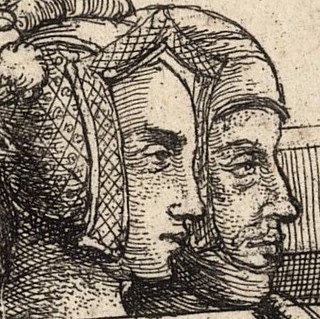
Blanche of Lancaster was a member of the English royal House of Plantagenet and the daughter of the kingdom's wealthiest and most powerful peer, Henry of Grosmont, 1st Duke of Lancaster. She was the first wife of John of Gaunt, the mother of King Henry IV, and the grandmother of King Henry V of England.

Hertford Castle was built in Norman times by the River Lea in Hertford, the county town of Hertfordshire, England. Most of the internal buildings of the castle have been demolished. The main surviving section is the Tudor gatehouse, which is a Grade I listed building. Parts of the bailey walls on the east side of the castle also still stand, and are a Grade II* listed building.
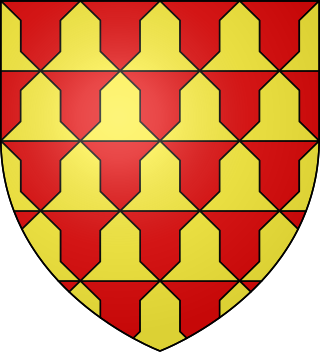
Robert de Ferrers, 6th Earl of Derby (1239–1279) was an English nobleman.

The Forest of High Peak was, in medieval times, a moorland forest covering most of the north west of Derbyshire, England, extending as far south as Tideswell and Buxton. From the time of the Norman Conquest it was established as a royal hunting reserve, administered by William Peverel, a follower of William I, who was based at Peveril Castle. The Royal Forest of Peak was bounded by the River Goyt to the west, the River Wye to the south, the River Derwent to the east and the River Etherow to the north. In 1305 it covered about 100 square miles.

Peveril Castle is a ruined 11th-century castle overlooking the village of Castleton in the English county of Derbyshire. It was the main settlement of the feudal barony of William Peverel, known as the Honour of Peverel, and was founded some time between the Norman Conquest of 1066 and its first recorded mention in the Domesday Survey of 1086, by Peverel, who held lands in Nottinghamshire and Derbyshire as a tenant-in-chief of the king. The town became the economic centre of the barony. The castle has views across the Hope Valley and Cave Dale.

Sir Godfrey de Foljambe was a prominent landowner and politician in fourteenth-century England, who was a Baron of the Exchequer and chief steward of the duchy of Lancaster. He went on to have a successful career as an Irish judge, including three years as Lord Chief Justice of Ireland. He was initially a servant of Philippa of Hainault before becoming a prominent member of the affinity of her son, John of Gaunt, Duke of Lancaster. His tomb can still be seen at All Saints Church, Bakewell.
Sir Hugh Waterton, was a trusted servant of the House of Lancaster.
Sir John Cockayne was an English soldier, politician and landowner whose wealth made him a major force in the affairs of Derbyshire under the House of Lancaster. After numerous acts of criminality in concert with other Midlands landowners, he became a member of the Lancastrian affinity centred on John of Gaunt and a supporter of Henry IV. He fought in two campaigns of the Hundred Years War but his violence and lawlessness continued and he was decidedly out of favour during the reign of Henry V. With power less concentrated in the early years of Henry VI, he was able to serve three terms as High Sheriff of Nottinghamshire, Derbyshire and the Royal Forests and to wield considerable power and influence. He represented Derbyshire no less than nine times and Warwickshire twice in the House of Commons of England.




